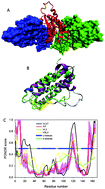Erythropoietin and co.: intrinsic structure and functional disorder†
Abstract
Erythropoietin (Epo) is a heavily glycosylated protein, with its main function being related to erythropoiesis, where it controls red blood cell production via interaction with the Epo receptor (EpoR). It also plays a number of important roles in various hormonal, growth factor, and cytokine pathways. These roles are defined by Epo partners, such as the homodimeric (EpoR)2 receptor, the heterodimeric EpoR/βCR receptor and hypoxia inducing factor (HIF). Although the main structural features of both Epo and EpoR are conserved in vertebrates, the secretion sites of Epo in mammals are different from those in other vertebrates. Both biosynthetic and synthetic analogues of this protein are available on the market. Several side effects, such as pure red cells aplaisa, increase the rate of cancer-related death in patients treated with recombinant Epo. The multifunctionality of Epo and the ability of this protein to serve as a hormone, a cytokine, and a growth factor suggest the presence of functional disorder, which is a typical “structural” feature of moonlighting proteins. The goal of this article is to evaluate the roles of intrinsic disorder in the functions of Epo and its primary interactors, EpoR, βCR, and HIF-1α.


 Please wait while we load your content...
Please wait while we load your content...